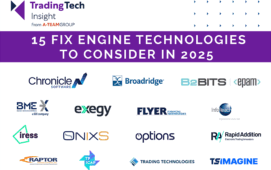
 By Matt Barrett, CEO of Adaptive.
By Matt Barrett, CEO of Adaptive.
We are told not to judge a book by its cover. Yet we are naturally drawn to content and platforms that, on the surface, stand out from the crowd. When quality design is the norm, as is increasingly the case in our digital world, customers’ expectations of exceptional user experience are normalised – this holds particularly true when it comes to the apps used to trade and manage money.
A trading platform is only as good as its user interface (UI) and user experience (UX). Trading apps can have the most sophisticated functionality in the world, but, if a user is not able to intuitively use and navigate these tools, they are effectively useless. Consumer expectations and the increasing depth and complexity of trading platforms have brought design to the fore – no longer a ‘nice to have’, thoughtful, differentiating UI and UX design is becoming as important as the technology that underpins them.
A catalyst for change – MT4/MT5
Just over a year ago, a seismic event rattled retail trading platforms when Apple’s App Store, the hub for a significant portion of investing app downloads, banned a crucial application used for FX trading – MT4 and MT5. The ban flew under the radar for many retail traders, yet the impact on their platforms was profound – necessitating moves to other services to hedge against any future bans.
It also triggered a migration of trading platforms away from native mobile apps to Progressive Web Applications (PWAs or browser-based apps), severing their reliance on App Stores and insulating them against future policy changes. While the transition to PWAs drew attention, another consequence of this race to rearchitect has been the renewed focus on UI and UX. In the face of such radical transition, firms have taken the opportunity to kill two birds with one stone – shoring up their platforms to provide global, reliable, access while ensuring the look, feel and functionality of their platform is a key differentiator.
For firms like Adaptive, the increasing demand for user experience and visual design is shaping how we approach building retail trading platforms for our clients. Mapping functionality and understanding users’ journeys has become as important as the technology stack that enables individuals to trade markets. As well as building low-latency, high-performance trading technology, our job is to give traders everything they need all in one place – allowing them to easily tailor platforms to their specific needs while maintaining a consistent experience.
Creating a world-class user interface is about more than simple aesthetics. Firms need to think carefully about who their core users are – what do they need? How do they access their trading app? How do they use trading tools? These questions play a vital role in crafting experience, integrating with third party tools and boosting usability. Platforms also need to think about how UI and UX will evolve – how shifting conditions and emerging asset classes will feed future functionality and how these can seamlessly plug into existing platforms.
As retail trading participation has surged in recent years, so has the number of personas – from novice investors, to battle-hardened traders – each with distinct needs and preferences. For firms rethinking their platform design, it is therefore sometimes difficult to know where to start. This is why we have developed our ‘UI Starter Kit’, a codified design system based on years of experience designing trading platforms that allows us to expedite the delivery of great looking desktop and mobile trading platforms. It caters for surging demand for design assets and gives us the tools needed to help firms build intuitive platforms at speed. From giving firms the foundations to give traders the data, market access and tools needed to act quickly and instinctively – they can start building a platform truly unique in its feel and functionality.
Design-enabled technology
Whether working on mobile or desktop, UI and UX design is often perceived by users as a reflection of quality. Our job is not only to help firms to build and turbocharge their platforms, it is increasingly about helping customers to harness the power of technology through design.
In tough markets, there is no time to sift through a clunky system for specific tools – access should be immediate and integrated. Understanding traders’ psychology and workflows is therefore becoming increasingly vital to the success of trading platforms – attracting customers through an attractive shop window and retaining them through unique functionality. Technology will continue to evolve, yet the principles of good, powerful UI and UX design will always remain – combining the two has become a competitive advantage.
Subscribe to our newsletter




